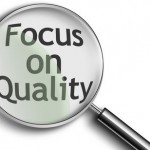Management

Total Quality Management (TQM) is a concept of continuous improvement that perceives quality as the most important aspect of the business strategy. It has been noted that “the TQM philosophy helps in organising the entire work force into small improvement groups, and creating a mind set of continuous improvement” (Davis, 2009, p.44). TQM elements are applicable by all businesses regardless of industry, geographical location, and even the volume of budget, although application of TQM elements needs to be taking into account a set of company-specific factors. There are differences in dimensions of quality between products and services and these differences have direct and substantial implications on LSC quality improvement initiatives. Specifically, for manufacturing businesses dimensions of quality include performance, features, reliability, conformance, durability, and serviceability. Quality dimensions of services, on the other hand, consist of timeliness, completeness, courtesy, consistency, accessibility, accuracy and responsiveness. Implementing all elements of TQM discussed below will have positive effects on the improvement of LSC quality dimensions above. Possible impact of all elements of TQM philosophy to LSC can be explained in the manner provided below. Meeting and exceeding customer expectations is one of the primary elements and ultimate outcome to be derived from TQM initiatives. Meeting and exceeding expectations students has positive contributions of LSC brand image and the amounts of profits in short-term and long-term perspectives. Quality priority covering all parts of the organisation is another integral element of TQM. Adoption of this principle by LSC would involve quality improvement initiatives not only in relation to content and delivery of teaching materials, but also constant and systematic quality improvements of campus facilities, internal customer services, marketing materials etc. By implementing constant quality improvement initiatives in relation to all parts and departments, LSC management will be able to re-reinforce positive impact to its image and…

Six sigma is “business management strategy used by many different industries in an effort to improve the quality of products or services produced by the business through the removal of defects and errors” (Business Dictionary, 2014, online). The primary commercial objectives of Six Sigma programs is associated with application of strategy based on measurements in order to improve wide range of processes and sub-processes with positive implications on quality of products and services. Application of Six Sigma philosophy is not exclusive to manufacturing processes, and the framework can be applied to a wide range of organisational practices and processes such as IT, administration, quality assurance, design, purchasing etc. Some of the leading companies operating diverse sectors such as General Electric, Motorola, Pepsico and even Amazon.com have been able to reduce the levels of operational costs and achieve greater levels of customer satisfaction through successful implementation of Six Sigma principles. Six Sigma philosophy integrates the principles of strategic planning, benchmarking, supply-chain management, organisational learning into a single approach in a synergistic manner, thus successful application of Six Sigma can benefit from advantages associated with each of these individual management principles. Along with its numerous advantages discussed above Six Sigma has certain disadvantages that include necessity for employees to undergo formal Six Sigma training programs before implementation of its principles. Moreover, positive implications of Six Sigma programs may not be evident in short-term perspective, and period of time of at least several months is required before Six Sigma programs make positive contribution to the levels of revenues after their implementation. Nevertheless, substantial advantages of Six Sigma outweigh its few disadvantages, and therefore application of Six Sigma in an appropriate manner makes a good business sense. DMAIC abbreviation stands for define, measure, analyse, improve and control, and each of these words represent consequent…

Business turnaround can be defined as financial recovery of the company after the period of poor performance. The financial recovery can be achieved through implementing a specific set of strategies by the senior level management. The most popular turnaround strategies include the following: Re-building around a profitable core business Re-branding Changing organisational culture. New product development Cost reduction through human resources downsizing and other measures The choice of turnaround strategies listed above by a company depends on a wide range of factors such as situation in the marketplace, availability of resources, the present pattern of organisational culture and others. Apple’s primary turnaround strategy relates to rebuilding around a profitable core business. Manufacturing of IPhone and IPad have proved to be highly profitable core business for Apple and the management is further increasing its focus on these core businesses through the introduction of IPad Mini, development of lower cost Iphones for emerging markets such as India and China, and committing to investment for further developments of IOS platform. Changing organisational culture can be specified as another turnaround strategy currently in use by Apple CEO Tim Cook. Under former CEO Steve Jobs, Apple organisational culture was famous for being overly harsh, competitive and even exploitative of employees. However, having a reputation for being a ‘nice guy’, Tim Cook is believed to be leading a ‘quiet cultural revolution’ to foster more communication between various levels of management and to make Apple nicer workplace in general. Specifically, the micro-management practice of former CEO Steve Jobs has been abandoned and the level of involvement of employees in strategic decision making has been increased. Moreover, new product development has been employed by Apple CEO as additional turnaround strategy. Apple is believed to be developing watches and television that might have the same impact on respective products…

This report has been prepared for the senior management and Board of Directors of children’s cancer charity in Northern Ireland and the report explains the concept of administrative management and how this role underpins all other functions. Moreover, the report explains the contribution of administrative management in meeting the needs of various stakeholder groups and assesses communication models used by administrative managers. The report is completed by explaining the need to redevelop various organisational systems in order to accommodate organisational change. Role of administrative managers are important for both, private and public sector organisations, however, the level of importance of this role is often underestimated by senior level management for a wide range of reasons. This reason may relate to the fact that unlike other organisational practices such as marketing and finance, the output of administrative management is not directly tangible. 1. Introduction 1 2. Role of Administrative Management 1 3. Contribution of Administrative Management in Meeting the Needs of Customers and Stakeholders 3 4. Communication Models Used by Administrative Managers 5 5. Need to Re-develop Systems to Accommodate Organisational Change 7 6. Conclusions 9 Apple BP General Motors Toyota Motor Corporation How do I receive the report? Once payment is made you will receive a link to you e-mail you have registered with on Pay Pal or the e-email you have entered when specifying bank details to download the report. The report is downloaded in PDF format. The link will stay active for 7 days. How can I use the report to complete my academic assignment/research? Reports and essays offered by research-methodology.net are professionally written samples in their respective areas. Reports and essays are intended to be used as guides and sources of secondary data for reference purposes. I did not receive the link/I can not download the report?…

Failure of plans in tourism industry, like any other industry is not a rare occasions. Plans may go wrong as a result of the impact of external environment, as well as, mistakes and shortcomings taken place in planning process. Shortcomings during the planning process resulting the in the failure of plans may take place in the following manners: Mistakes may occur during the first stage of planning process, which is study recognition and preparation. For example, management may decide to conduct relevant study on regional levels, when the scope of the study necessitates data collection on the national level, thus compromising the quality of the plan from the outset of the planning process. Moreover, individuals responsible for tourism planning may fail to formulate SMART objectives. In this case, objectives may be too vague and lack deadlines, and it would be not possible to assess the level of achievement of these objectives in an appropriate manner. Shortcomings planning process can also take place during the stage of survey of existing data. Specifically, such shortcomings may involve collection of outdated data, collection of irrelevant data, collection of data from biased and unreliable sources etc. Arguably, implementation of new surveys can be specified as one of the major stages in tourism planning process that accommodates the most mistakes. Such mistakes may be caused due to the incompetence and the lack of previous experiences and they may involve selection of inappropriate data collection tools, sampling mistakes, and others. Analysis of secondary and primary data can be mentioned as another stage in the planning process in tourism where mistakes can happen possibly resulting in the failure of the plan. Mistakes in data analysis may involve failure to identify common patterns within the information provided by survey respondents, failure to achieve a required level of depth…

Planning process for tourism industry comprises the following stages: 1. Study recognition and preparation. The first stage in planning process is associated with the recognition of the need for the strategy in order to obtain and/or increase competitive advantage to contribute to long-term growth. Depending on available budget and a range of other factors, studies may be planned to be conducted on local regional or national levels. 2. Setting of objectives or goals for the strategy. Goals and objectives need to be formulated according to SMART principle, where the acronym stands for specific, measurable, achievable, realistic and time-bound. 3. Survey of existing data. The survey of existing data or secondary research can be done through analysing relevant information available on wide range of tourism reviews websites, newspapers, magazines, books and other online and offline published materials. The types of data that need to be collected from these sources include, but not limited to patterns of tourist behaviours, availability and quality of accommodation, impacts of environmental factors, social and cultural characteristics of tourism destinations etc. Importantly, the survey of existing data should cover all three directions: the state of issues at present, projected changes in the state of issues, and outline of principles for monitoring for the future. 4. Implementation of new surveys. New surveys are conducted in order to obtain fresh data and/or fill the information gap in relation to the tourism industry. Surveys can be conducted through online or offline questionnaires or interviews. When conducting the survey it is very important to select respondents i.e. sample group members from amongst target customers for tourism destinations. 5. Analysis of secondary and primary data. In case of questionnaires, data analysis can be done through representing collected information in bar-charts, pie-charts etc. In case of interviews, on the other hand, data analysis may involve finding common patterns…

This paper represents a business plan sample for Product Placement Opportunities®, a marketing services company that provides a platform for medium sized businesses to engage in product placement in a cost-effective manner through its website www.pp-opportunities.com. The business plan is built upon the gap in the in the marketing services industry that relates to allowing media, special event and computer games businesses to utilise their product placement opportunities in a direct manner, without using the services of marketing agencies. The comprehensiveness of the business plan is ensured by explaining mission statement, business strategy and objectives in a detailed manner. The main source of revenue for Product Placement Opportunities® relates to charging media, special event and computer games and other businesses for advertising their product placement opportunities on www.pp-opportunities.com. Price skimming pricing strategy has been chosen as the most suitable for the business. Analysis of principal personnel qualifications and experience contained within the plan highlights the ways in which competitive advantages are going to be derived. Moreover, cash flow forecast, profit and loss accounts forecast and balance sheet associated with the business plan have been developed on the basis of situational analysis and analysing market size for Product Placement Opportunities® services. The business plan also contains discussion related to relevant legal requirements, such as the company’s legal structure, commercial dealings, insurance and others. Glossary of Terms 1 1. Description of Business 2 2. The Mission and Vision Statement 3 2.1 Business Idea 3 2.2 Trading Status 4 2.3 Management & Ownership 4 2.4 Business Objectives 5 2.5 Business Strategies 5 3. Product and/or Service Plan 6 3.1 Product Placement Opportunities® service description 6 3.2 Product Placement Opportunities® Unique Features 7 3.3 Pricing Strategy& Value Issues 7 4. The Market Plan 8 4.1 Market Research Methodology 8 4.2 Secondary Research 8 4.3…

There are several principal differences between public sector and private sector organisations, and these differences include organisational aims and objectives, organisational stakeholders and stakeholder expectations, the levels of public scrutiny, the levels of impact by political factors and others. Organisational Aims and Objectives Private sector organisations pursue the main objective of profit maximisation. Top level executive and marketing management in private sector organisations may attempt to create an image of pursuing other objectives as well such as protecting the environment, making the lives of people more convenient, and creating value for people in many other ways. However, these objectives for private sector organisations are secondary, and they have been developed only to aid the primary objective of profit maximisation. Public sector organisations, on the other hand, usually pursue aims and objectives other than profit maximisation. Moreover, objectives of public sector organisations in the UK may relate to a wide range of areas such as policing, providing education, providing healthcare etc. Organisational Stakeholders and Stakeholder Expectations Customers and shareholders are the most important organisational stakeholders for private sector organisations and their expectations are straightforward. Specifically, customers expect to get the best possible deal from the business, whereas the expectations of shareholders are closely associated with increasing profitability in short-term and long-term perspectives. In case of public sector organisations, on the other hand, stakeholder expectations are closely associated with the delivery of products and services in an adequate manner. It can be stated that population is the most important stakeholder group for public sector organisations. The Levels of Public Scrutiny Public sector organisations are generally subjected to scrutiny to a greater extent compared to private sector organisations in the media and from the government. Moreover, the main reason behind this difference relates to the sources of funding of these…

There is set of factors that effect team functioning. These factors include, but not limited to the nature of group norms, the level of cohesiveness, team leadership, rewards and others. Group norms resemble a code of conduct that specifies the extent of acceptable behaviour within the groups. As an important factor impacting team functioning, group norms need to be formulated in a clear and straightforward manner. Moreover, group members need to be communicated about penalties for deviating form group norms. Group cohesiveness can be explained as the level of attractiveness of the group to its members and is a major factor impacting group functioning. Managers need to be focusing on increasing the levels of cohesiveness through associating being group members with personal and professional growth, as well as, a range of tangible benefits. Moreover, leadership plays substantial role on the effectiveness of team functioning. Team leaders need to be able to command respect from team members and they need to be emotionally intelligent as well. Importantly, team leaders need to be able motivate each member of team in personal levels. Rewards associated with team performance can be listed as another important factor impacting team functioning. Rewards to team members need to comprise tangible elements such as financial compensation and various perks, as well as, intangible elements such as celebration of achievement, recognition of contribution of each individual team member in formal and informal ways. Failure to achieve the positive impact of the factors listed above may cause the formation of dysfunctional teams that are not well positioned to achieve organisational aims and objectives.

There are set of factors that impact employee behaviour in direct and indirect ways. These factors can be internal to organisation such as work culture, leadership, job responsibilities relationships with colleagues etc., or external such as the extent of work-life balance, changes in personal circumstances, employee cultural background, the extent of interpersonal skills etc. Work culture can be defined as “applying the general characteristics of culture to the specifics of how people work at a point of time and place” (Moran et al., 2007, p. 30) and work culture is one of the major factors impacting employee behaviour. Work culture is usually set by founder(s) of organisation, but it can change over a course of time. In simple terms, in order to survive employees have to fit in the current work culture. The quality of organisational leadership has also great impact on employee behaviour in a way that effective organisational leaders can inspire and motivate employees for greater performance, at the same time when ineffective leaders can cause employee knowledge, skills and competencies not being fully utilised. Employee job responsibilities can be mentioned as important factor impacting employee behaviour because extensive range of roles and responsibilities can cause burnout for employees with all the negative consequences. In personal level, the extent of work-life balance of employees has direct and significant implications on their behaviour. Specifically, lack of work-life balance is most likely to have negative implications on employee behaviour and performance in various levels. Similarly, employee-specific factors such as cultural background and interpersonal skills and competencies greatly affect employee behaviours. Therefore, managers need to take into account these differences when dealing with each individual employee. References Moran, R.T., Harris, P.R. & Moran S.V. (2007) “Managing Cultural Differences: Global Leadership Strategies for the 21st Century” 7th edition, Routledge
